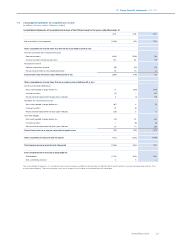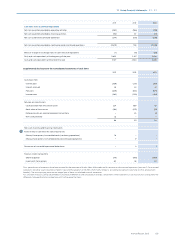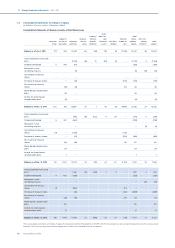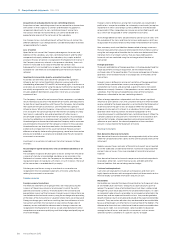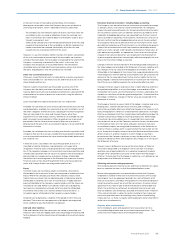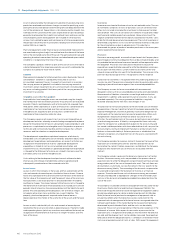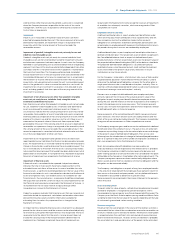Philips 2013 Annual Report Download - page 140
Download and view the complete annual report
Please find page 140 of the 2013 Philips annual report below. You can navigate through the pages in the report by either clicking on the pages listed below, or by using the keyword search tool below to find specific information within the annual report.
11 Group financial statements 11.9 - 11.9
140 Annual Report 2013
Assets manufactured by the Company include direct manufacturing costs,
production overheads and interest charges incurred for qualifying assets
during the construction period. Government grants are deducted from the
cost of the related asset. Depreciation is calculated using the straight-line
method over the useful life of the asset. Depreciation of special tooling is
generally also based on the straight-line method. Gains and losses on the
sale of property, plant and equipment are included in Other business
income. Costs related to repair and maintenance activities are expensed in
the period in which they are incurred unless leading to an extension of the
original lifetime or capacity.
Plant and equipment under finance leases and leasehold improvements
are amortized using the straight-line method over the shorter of the lease
term or the estimated useful life of the asset. The gain realized on sale and
operating leaseback transactions that are concluded based upon market
conditions is recognized at the time of the sale.
The Company capitalizes interest as part of the cost of assets that take a
substantial period of time to become ready for use, which is defined by the
Company as a period of more than 6 months.
Goodwill
Measurement of goodwill at initial recognition is described under ‘Basis of
consolidation’. Goodwill is subsequently measured at cost less
accumulated impairment losses. In respect of investment in associates,
the carrying amount of goodwill is included in the carrying amount of
investment, and an impairment loss on such investment is not allocated to
any asset, including goodwill, that forms part of the carrying amount of
investment in associates.
Intangible assets other than goodwill
Acquired finite-lived intangible assets are amortized using the straight-
line method over their estimated useful life. The useful lives are evaluated
annually. Patents and trademarks with a finite useful life acquired from
third parties either separately or as part of the business combination are
capitalized at cost and amortized over their remaining useful lives.
Intangible assets acquired as part of a business combination are
capitalized at their acquisition-date fair value.
The Company expenses all research costs as incurred. Expenditure on
development activities, whereby research findings are applied to a plan or
design for the production of new or substantially improved products and
processes, is capitalized as an intangible asset if the product or process is
technically and commercially feasible and the Company has sufficient
resources and the intention to complete development.
The development expenditure capitalized comprises of all directly
attributable costs (including the cost of materials and direct labor). Other
development expenditures and expenditures on research activities are
recognized in the Statement of income. Capitalized development
expenditure is stated at cost less accumulated amortization and
impairment losses. Amortization of capitalized development expenditure
is charged to the Statement of income on a straight-line basis over the
estimated useful lives of the intangible assets.
Costs relating to the development and purchase of software for both
internal use and software intended to be sold are capitalized and
subsequently amortized over the estimated useful life.
Leased assets
Leases in which the Company is the lessee and has substantially all the
risks and rewards of ownership are classified as finance leases. Finance
leases are capitalized at the commencement of the lease at the lower of
the fair value of the leased assets and the present value of the minimum
lease payments. Each lease payment is allocated between the liability
and finance charges. The interest element of the finance cost is charged to
the Statement of income over the lease period so as to produce a constant
periodic rate of interest on the remaining balance of the liability for each
period. The corresponding rental obligations, net of finance charges, are
included in other short-term and other non-current liabilities. The
property, plant and equipment acquired under finance leases is
depreciated over the shorter of the useful life of the assets and the lease
term.
Leases in which substantially all risks and rewards of ownership are
retained by the lessor are classified as operating leases. Payments made
under operating leases (net of any incentives received from the lessor) are
recognized in the Statement of income on a straight-line basis over the
term of the lease.
Inventories
Inventories are stated at the lower of cost or net realizable value. The cost
of inventories comprises all costs of purchase, costs of conversion and
other costs incurred in bringing the inventories to their present location
and condition. The costs of conversion of inventories include direct labor
and fixed and variable production overheads, taking into account the
stage of completion and the normal capacity of production facilities. Costs
of idle facility and abnormal waste are expensed. The cost of inventories is
determined using the first-in, first-out (FIFO) method. Inventory is reduced
for the estimated losses due to obsolescence. This reduction is
determined for groups of products based on purchases in the recent past
and/or expected future demand.
Provisions
Provisions are recognized if, as a result of a past event, the Company has a
present legal or constructive obligation that can be estimated reliably, and
it is probable that an outflow of economic benefits will be required to settle
the obligation. Provisions are measured at the present value of the
expenditures expected to be required to settle the obligation using a pre-
tax discount rate that reflects current market assessments of the time
value of money and the risks specific to the obligation. The increase in the
provision due to passage of time is recognized as interest expense.
A provision for warranties is recognized when the underlying products or
services are sold. The provision is based on historical warranty data and a
weighing of possible outcomes against their associated probabilities.
The Company accrues for losses associated with environmental
obligations when such losses are probable and can be estimated reliably.
Measurement of liabilities is based on current legal and constructive
requirements. Liabilities and expected insurance recoveries, if any, are
recorded separately. The carrying amount of liabilities is regularly
reviewed and adjusted for new facts and changes in law.
The provision for restructuring relates to the estimated costs of initiated
reorganizations, the most significant of which have been approved by the
Board of Management, and which generally involve the realignment of
certain parts of the industrial and commercial organization. When such
reorganizations require discontinuance and/or closure of lines of
activities, the anticipated costs of closure or discontinuance are included
in restructuring provisions. A liability is recognized for those costs only
when the Company has a detailed formal plan for the restructuring and
has raised a valid expectation with those aected that it will carry out the
restructuring by starting to implement that plan or announcing its main
features to those aected by it. Before a provision is established, the
Company recognizes any impairment loss on the assets associated with
the restructuring.
The Company provides for onerous contracts, based on the lower of the
expected cost of fulfilling the contract and the expected net cost of
terminating the contract. Before a provision is established, the Company
recognizes any impairment loss on the assets associated with that
contract.
The Company records a provision for decommissioning costs of certain
facilities. Decommissioning costs are provided at the present value of
expected costs to settle the obligation using estimated cash flows and are
recognized as part of the cost of the particular asset. The cash flows are
discounted at a current pre-tax rate that reflects the risks specific to the
decommissioning liability. The unwinding of the discount is expensed as
incurred and recognized in the Statement of income as a Financial
expense. The estimated future costs of decommissioning are reviewed
annually and adjusted as appropriate. Changes in the estimated future
costs or in the discount rate applied are added to or deducted from the
cost of the asset.
The Company is a provider of electrical equipment that falls under the EU
Directive on Waste Electrical and Electronic Equipment (WEEE). The
directive distinguishes between waste management of equipment sold to
private households prior to a date as determined by each EU Member
State (historical waste) and waste management of equipment sold to
private households after that date (new waste). A provision for the
expected costs of management of historical waste is recognized when the
Company participates in the market during the measurement period as
determined by each Member State, and the costs can be reliably
measured. These costs are recognized as Other business expenses in the
Statement of income. With respect to new waste, a provision for the
expected costs is recognized when products that fall within the directive
are sold and the disposal costs can be reliably measured. Derecognition
takes place when the obligation expires, is settled or is transferred. These
costs are recognized as part of Costs of sales. With respect to equipment



